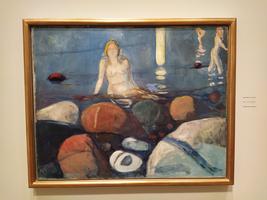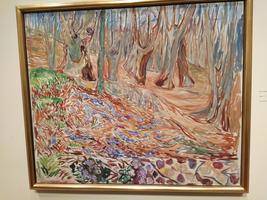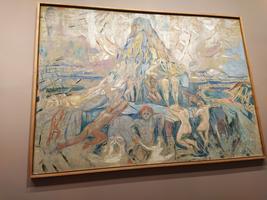Oslo
|
|
Visiting the Munch Museum in Oslo, Norway, was an experience like no other. As one of the most significant museums dedicated to a single artist, it holds the world’s largest collection of works by Edvard Munch, the Norwegian painter best known for The Scream. The new museum, which opened in 2021 in the Bjørvika district, is a striking 13-floor modern glass tower, offering a deep dive into Munch’s life, art, and legacy. From the moment I entered, the atmosphere was immersive. The open lobby, with its high ceilings and contemporary design, immediately set the stage for an extraordinary artistic experience. The space was lively, filled with visitors eager to explore the vast collection of over 28,000 works. The ground floor serves as the welcoming area, featuring the ticket desk, museum shop, and café. The shop was filled with beautifully designed souvenirs, including Munch-inspired prints, books, and home decor. The café, Kranen, had floor-to-ceiling windows overlooking the Oslo waterfront, making it the perfect spot to grab a coffee before starting the museum tour. The second and third floors are dedicated to temporary exhibitions and educational activities. The museum often hosts contemporary artists whose works are influenced by Munch, creating a dialogue between past and present. One of the interactive highlights on these floors was a digital experience where I could step into Munch’s paintings through augmented reality. This gave an entirely new perspective on his brushstrokes and emotional depth. The learning center also had short films and art workshops, making it an engaging space for both children and adults. For many visitors, the most anticipated part of the museum is the fourth and fifth floors, where Munch’s most famous paintings are displayed. These floors house multiple versions of The Scream, which Munch created using different techniques—paint, pastel, and lithograph. Seeing the artwork in person was surreal. The raw emotion in the distorted face and swirling sky was even more powerful than I had imagined. These floors also feature other iconic works like:
Dim lighting and deep-colored walls enhanced the intensity of these paintings, making the viewing experience truly immersive.
The sixth and seventh floors focus on Munch’s lesser-known works, including his photography, prints, and woodcuts. I was fascinated to learn that Munch was an early experimenter with self-portrait photography. He often used double exposure, creating eerie, ghostly images that reflected his emotional state. These floors also showcase his lithographs and woodcuts, highlighting his ability to express deep emotion even in black-and-white prints. The eighth and ninth floors provide a more personal look into Munch’s life, displaying artifacts from his home, letters, and personal belongings. His handwritten notes and diaries offered insight into his struggles with mental health, loneliness, and creative process. One of the most moving exhibits was a re-creation of his studio, complete with his old easel, paintbrushes, and unfinished works. This gave a rare glimpse into how he worked and the emotions he poured into his paintings. chniques Munch used throughout his career showed just how versatile and innovative he was. The tenth floor, known as the Sky Room, is a multi-purpose space for lectures, film screenings, and performances. It also offers breathtaking views of the Oslo fjord, providing a moment of reflection after exploring the emotional depths of Munch’s work. |



